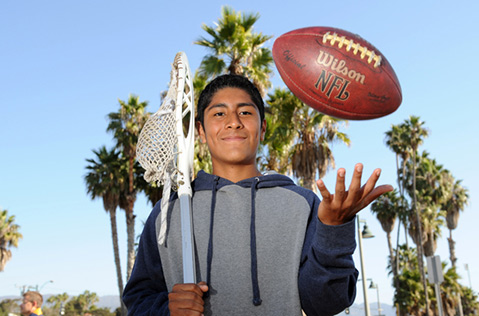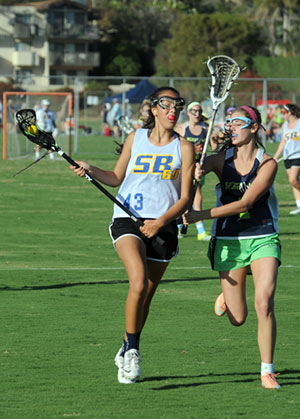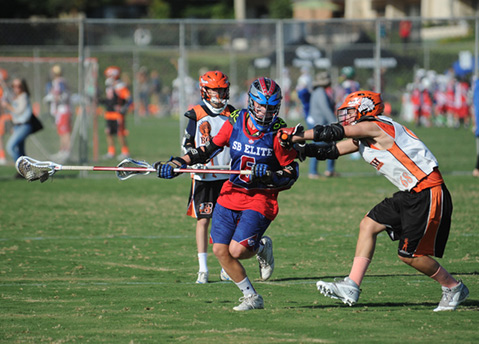Lacrosse and Rugby
The Rise of Lacrosse and Rugby in S.B.

It was a mid-October weekend, the heart of the football season, and the sport with the highest participation in Santa Barbara was lacrosse. Eighty teams from up and down the state wielded sticks in the Santa Barbara Showdown, a youth lacrosse tournament on the vast polo fields in Carpinteria.
UCSB has fielded men’s and women’s lacrosse clubs for a number of years, but the formation of teams for children ages 8 and up is a recent development in the community. Proponents say lacrosse is the fastest-growing sport in the country. Annual surveys by U.S. Lacrosse show that between 2001 and 2013, the number of players on organized lacrosse teams grew 194 percent to 746,859 ― almost 700,000 at the youth and high school levels. Participation in Santa Barbara has grown from a handful of players at private prep schools to several hundred youths in the Santa Barbara Lacrosse Association (SBLA), and the three city high schools are going to field CIF lacrosse teams in the spring of 2015.
Rugby is another increasingly popular sport that is between football and lacrosse on the scale of physical contact. It has grown by a magnitude of some 300 percent in a decade, to a present total of 115,000 registered members of U.S.A. Rugby. UCSB, Westmont College, and SBCC have long-standing clubs, while older ruggers keep playing for the Santa Barbara Grunion and the Fossils. Meanwhile, the Santa Barbara Stingrays youth rugby program is entering its fourth year. About 100 children ages 10 and up are practicing to play on age-group rugby teams.

Forrest Galante, head coach of the Stingrays, gives a barbed recommendation to rugby, a sport he played for 20 years: “Rugby is truly a man’s sport of camaraderie and commitment. Every single kid gets to tackle, run, and score. It’s for rough-and-tumble kids. A lot of them play football, too. Lacrosse is for kids who couldn’t make the football team.”
Mike Terry, the lacrosse coach at Santa Barbara High, retorts that his sport has a multifaceted appeal: “From football, it takes physicality. From soccer, endurance. From basketball, set plays like pick-and-rolls. From hockey, the transition game and playing behind the net.”
Rugby and lacrosse coexist on the fields at upper Elings Park. There is an overlap in their seasons, the rugby youth teams beginning league play in January and the lacrosse season starting in late February.
Terry came to Santa Barbara from Pennsylvania, where he played lacrosse for a small college. Rick Lehman, the president and prime mover of the SBLA, also brought his knowledge and enthusiasm for the sport from the East. He was a pediatric critical-care specialist at the University of Virginia, in the heart of lacrosse-land. His three boys were playing the sport when he took a job at Cottage Hospital in 2010. The SBLA was then a fledgling nonprofit organization. “It had no base,” Lehman said. “I expressed a desire to get it off the ground.”
Lehman began teaching PE classes in lacrosse at Mountain View School and holding clinics at other venues. “By the winter of 2011, we had so many kids we decided to run a spring league,” he said. “It’s grown 30-40 percent every year.” In 2012, the SBLA fielded its first elite traveling teams. With the support of the SBLA ― “over $50,000 worth of equipment of uniforms,” Lehman said ― Dos Pueblos, San Marcos, and Santa Barbara highs will compete in the Condor League with the established lacrosse teams at Laguna Blanca, Cate, Dunn, Midland, and Ojai Valley next spring.
Lacrosse can complement rather than compete with other sports, Lehman said. “We will always advocate kids playing multiple sports,” Lehman said. “We do not want to have lacrosse year-round.”
The Santa Barbara Showdown in October was an out-of-season opportunity for elite lacrosse teams to showcase their talents. It was run by UCSB coaches Paul Ramsey and Mike Allan in consort with the SBLA, which fielded eight teams.

Darwin Miguel would have been out there, but he is a lacrosse player who made the football team. The 5’6”, 130-pound junior played cornerback for the Laguna Blanca Owls this fall. “Playing cornerback is a huge responsibility, knowing you’ve got to make the tackle or it’s in the end zone,” Miguel said. “Football got me in the mood to hit people. I’m a goalkeeper in lacrosse. I have lots of opportunities to hit people when they get into the crease.”
The legal contact zone in lacrosse is between the shoulders and the waist, only at the front of the body. (Different rules apply to girls’ lacrosse; no bodily contact is allowed.) There is a lower risk of concussions in lacrosse than in football, but Miguel said, “There are definitely some injuries in both sports. You’re going to get bruises if you play either one. The lacrosse ball can hit you hard. You don’t want to drop and cry from pain.”
It was his eagerness to try different sports, along with being a good student, that enabled Miguel ― the son of a custodian and a house cleaner ― to attend Laguna Blanca, like his brother Brian before him. Both boys joined the Santa Barbara School of Squash, another exceptional sport in the community, and received scholarships to the Hope Ranch prep school with the help of Debbie Brown, director of the squash program. “We’re small but mighty,” Brown said. “We give the boys freedom. Brian and Darwin didn’t have to focus on squash.”
Darwin said he was enthralled by the team spirit in football when he watched his brother, now a student at the University of Oregon, play on Laguna Blanca’s eight-man team. He is glad he tried it, but if he had to choose, he’d take lacrosse. “Football is definitely a lot more popular,” he said, “but lacrosse is more unique.”
For information about lacrosse and rugby in the community, see sblacrosse.org and santabarbararugby.com.



